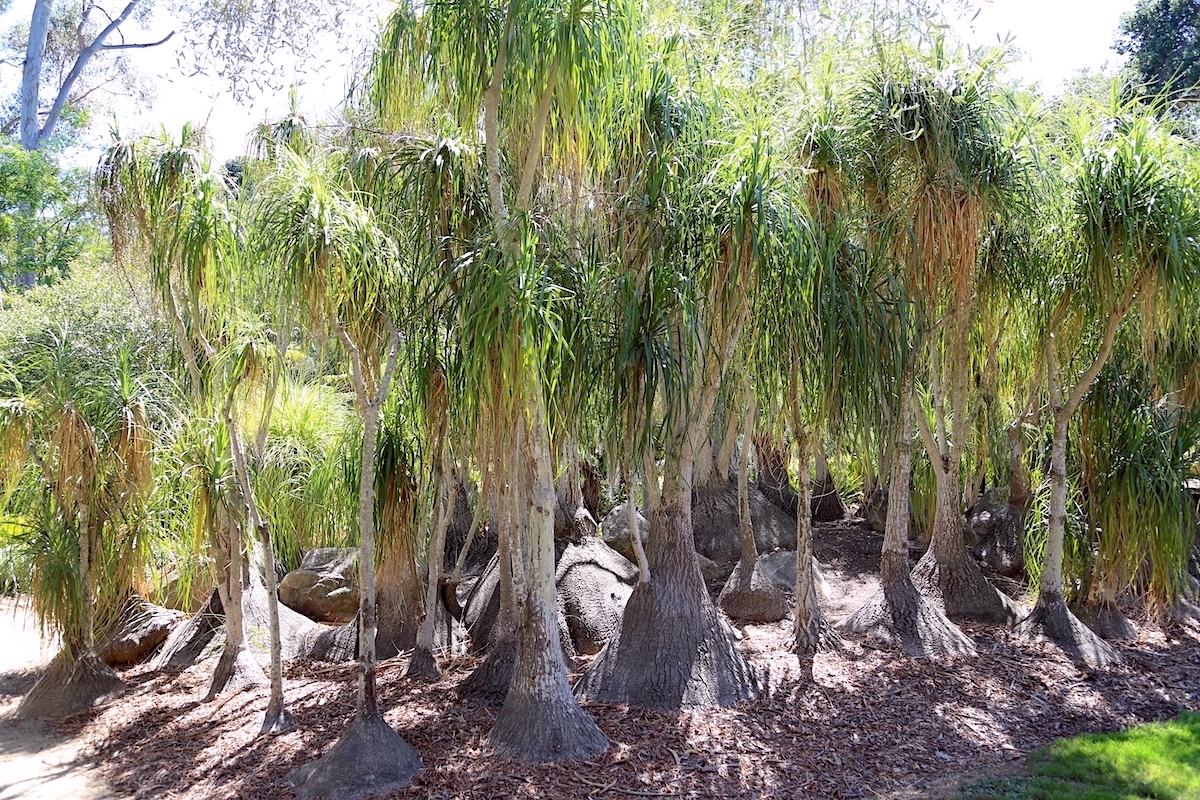
Yes, You Can Grow Beaucarnea recurvata (ponytail palm)
In my new video, we observe and learn how to relocate a Beaucarnea recurvata (ponytail palm) that had become too large for a homeowner's side yard. "Betty" is a gorgeous specimen: ten to 12 years old, nicely branched, and 7 feet tall; with a 3-foot-diameter, half-ton caudex.
No doubt you'll marvel---as I did---at how Laura Eubanks and the Design for Serenity team tackled the tree's removal and replanting. All involved---myself, Laura, Kathy (the previous owner) and Cathy (new owner) are happy with Betty's re-homing.
Horticulturally, these are "caudiciform" succulents. The onion-shaped caudex (swollen base) stores water and nutrients. Topknots of pendant, ribbon-like leaves inspired the common name ponytail palm, but IMHO it's more of a mop.
Yes, you do need the right spot for this exotic, easy-care tree succulent with loads of personality. Hm. How about your living room? Small ones make perfectly...
Polite houseplants
A beaucarnea will sit for years in a pot looking much the same---slightly larger over time---and needing minimal attention or water.
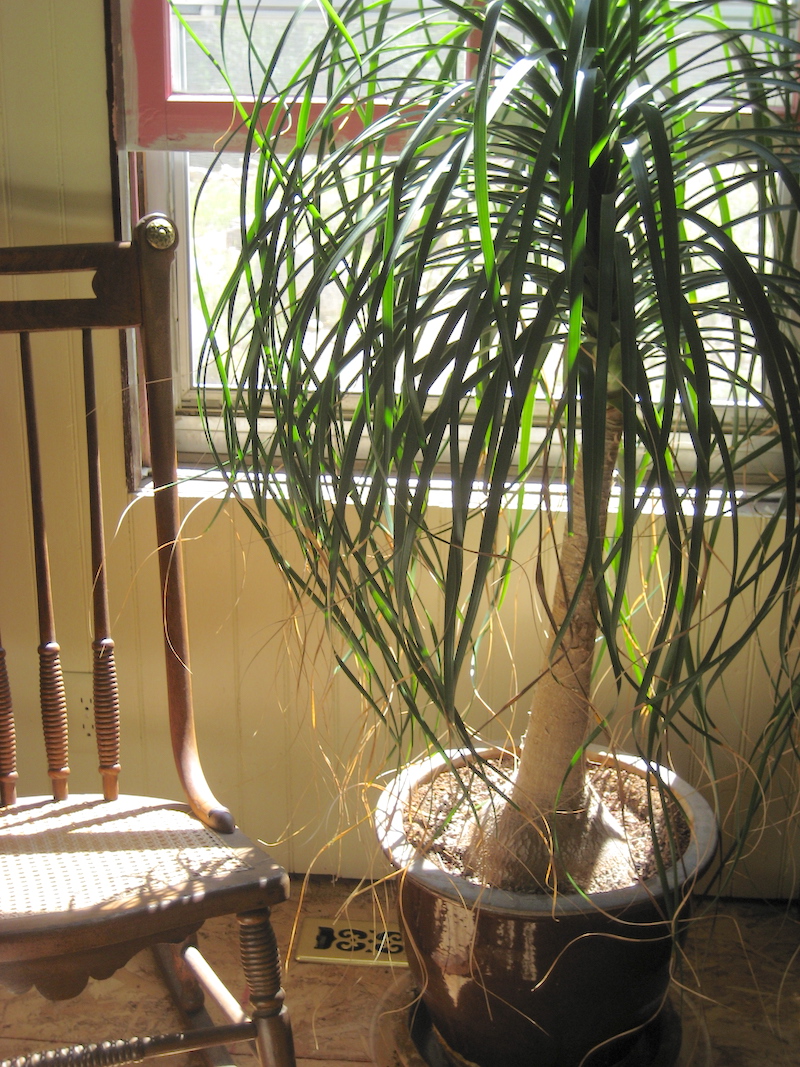
Beaucarnea recurvata thrives in a Georgetown, Colorado home in spite of below-freezing outdoor temps.
Potted beaucarneas grow about an inch or so in diameter and 6 inches in height a year. They need repotting every two to three years (when smaller than a grapefruit), and every 5 to 6 years if larger.
Repot when there's an inch or so gap between the soil at the base of the caudex and the inner rim of the pot.
Outdoors, because of air circulation, pests are seldom a problem. Indoors, watch for mealy bugs and treat accordingly.
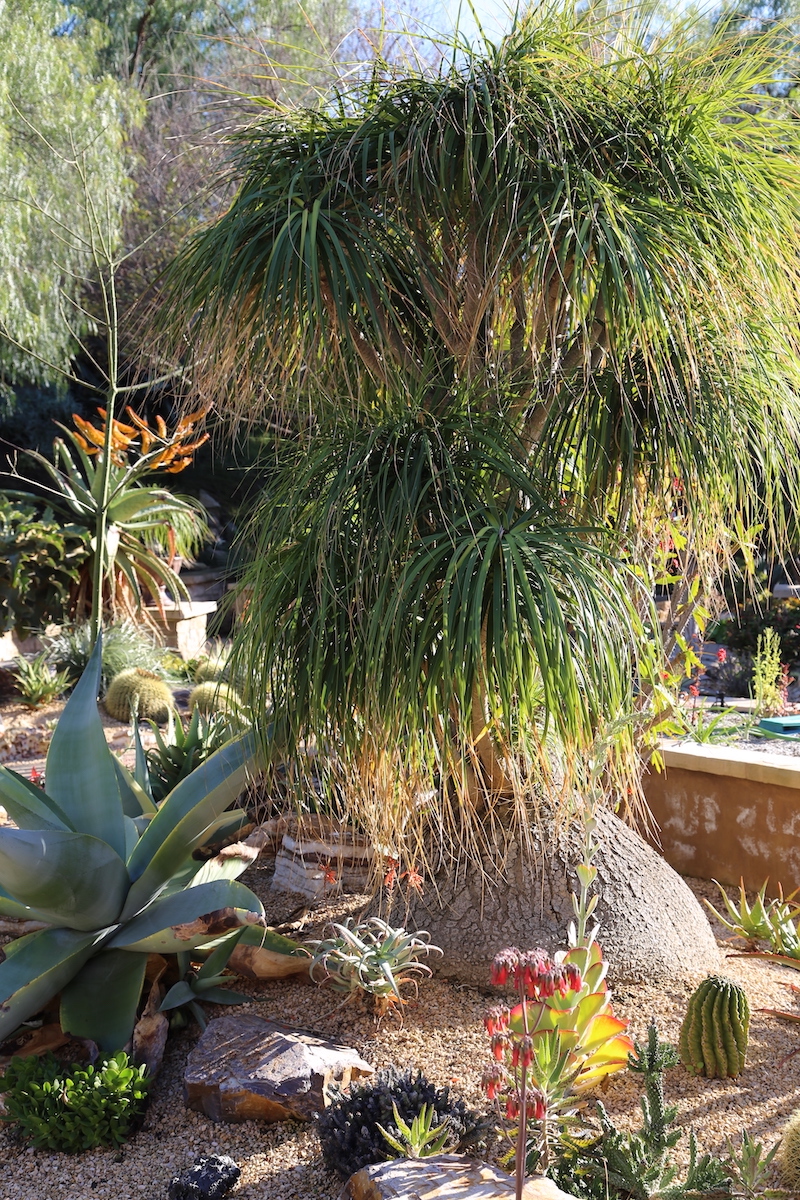
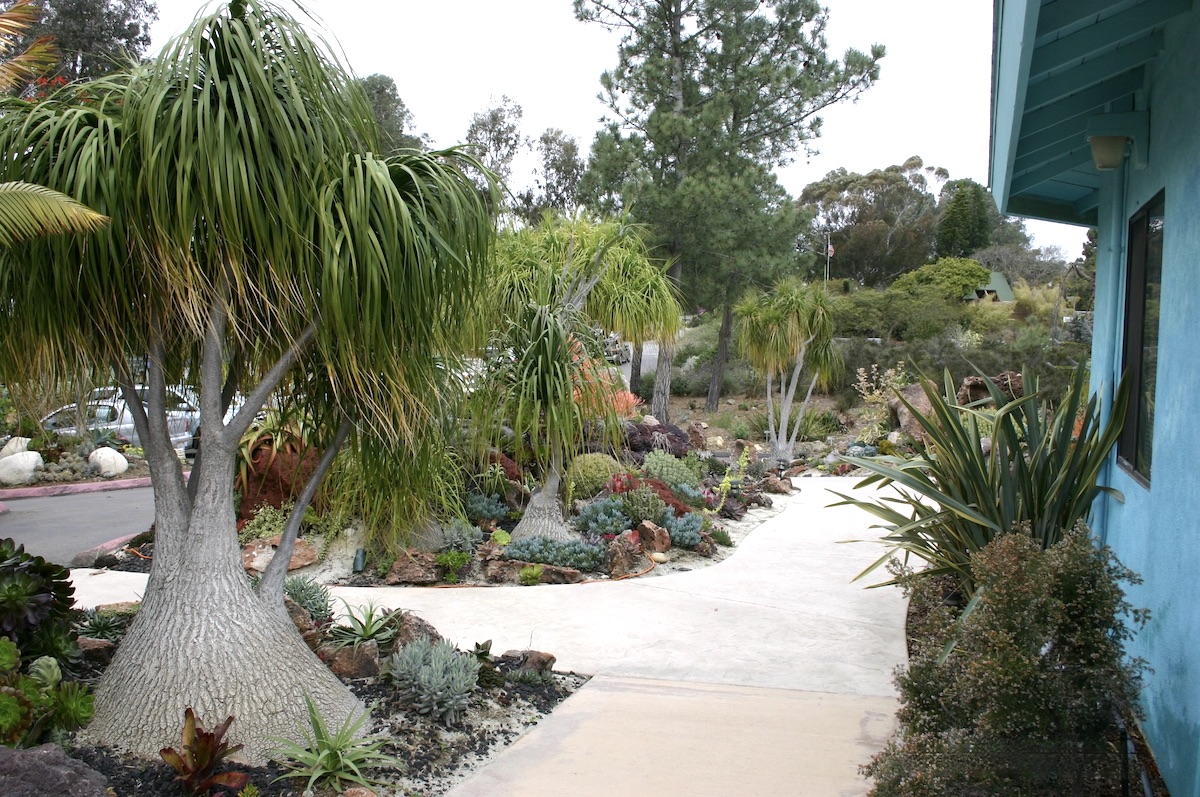
Mature beaucarneas enhance the undersea succulent display at the San Diego Botanic Garden
Outdoors: A terrific succulent tree
If yours is a mild climate, consider adding one or more beaucarneas to your low-water landscape. I planted four in my own garden about a decade ago.
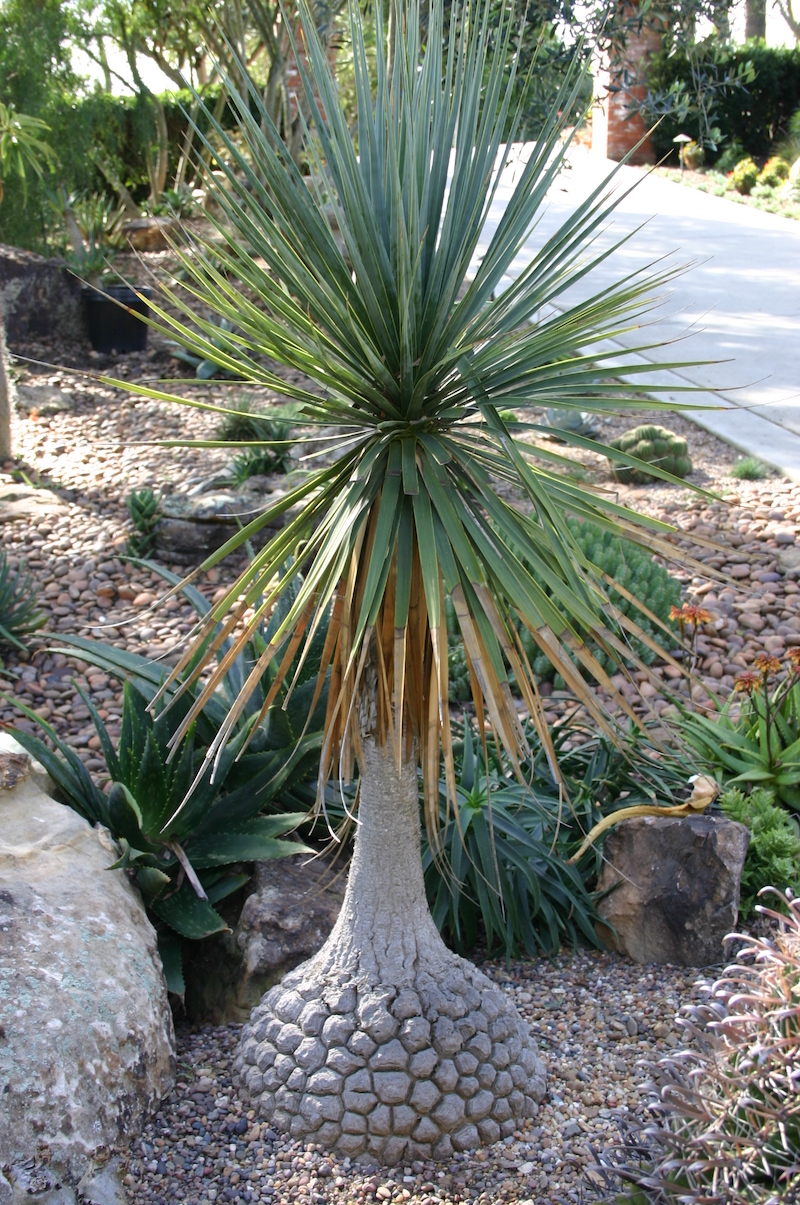
Beaucarnea stricta, 5 or 6 years old. From Designing with Succulents
Leaves of Beaucarnea stricta are stiff and give the crown a pincushion appearance. The stricta species is less common than recurvata and tends to be more prized---and pricey.

A decades-old Beaucarnea stricta has a magnificent fissured caudex. Dry leaves that cling to the trunk shade it in summer and insulate it in winter. Palomar College succulent garden, San Marcos, CA
Highly desirable yet harder to come by is this variegate, below, of Beaucarnea recurvata with green-and-yellow leaves.
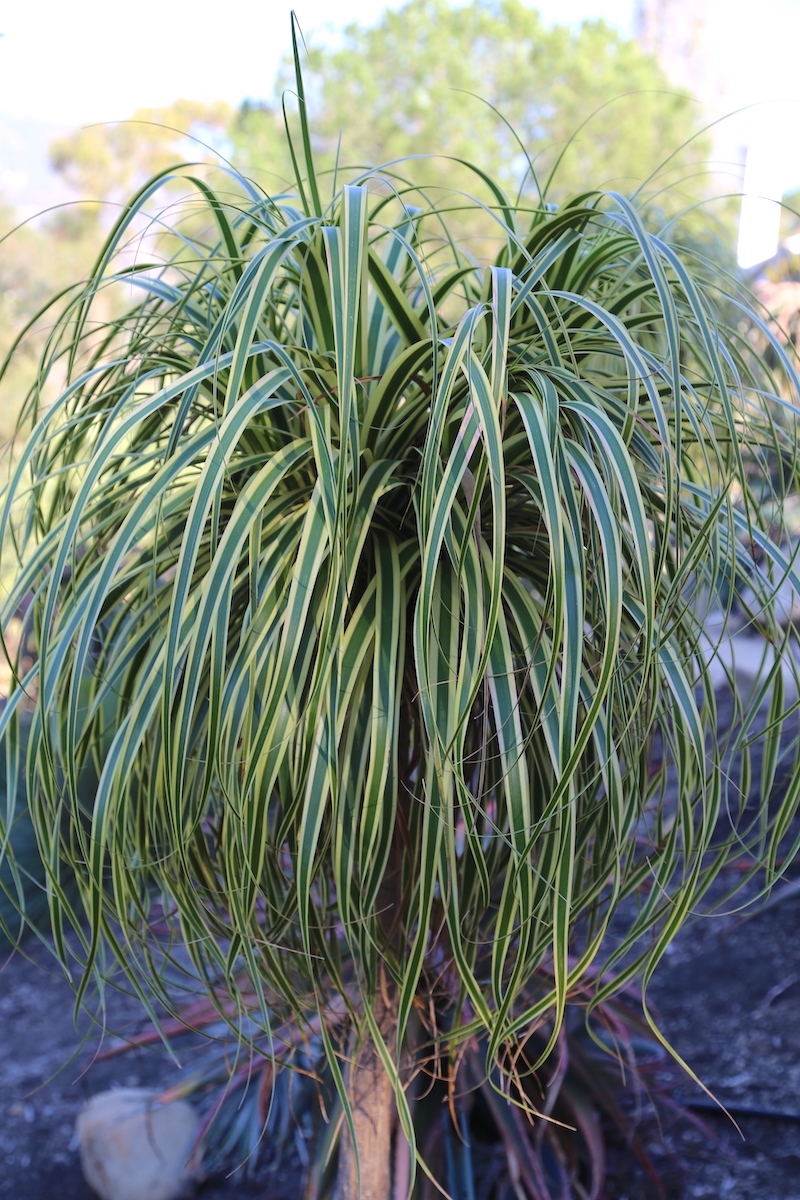
Beaucarnea recurvata 'Variegata'
New growth of seldom-seen Beaucarnea guatemalensis flushes red.
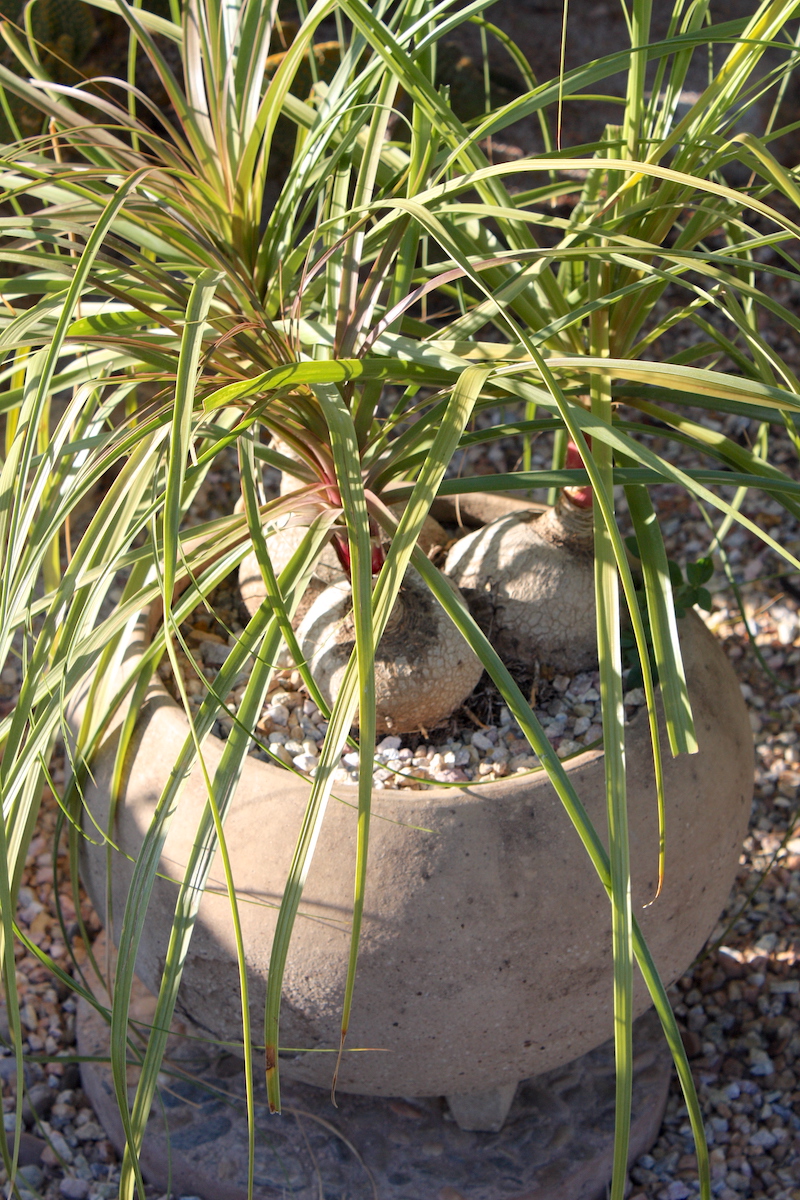
A three-caudex cluster of Beaucarnea guatemalensis
Cultivation
Beaucarneas, which are not palms, are native to Mexico. I've read they don't do well in temps below 50 F, but mine have been fine after nighttime temps dropped into the 30s and even below freezing (32 F).
Mary and Gary Irish, in their book Agaves, Yuccas and Related Plants, state that "as the plant matures it comes to tolerate very harsh conditions. Mature plants have survived freezes down to around 20F."
Err on the side of caution, and cover small in-ground specimens when frost is forecast. If your outdoor beaucarneas are potted, you may want to move them to a warmer, more sheltered spot.
Locate an indoor beaucarnea where it'll get bright light from a window, and rotate it monthly for balanced growth. Outdoors, the plants like the same exposure as other succulents: Full sun along the coast and half-day sun inland. They're not suited for cold, rainy climates.
Clusters of leaves act as parasols to protect the bark from strong sunlight. Caution: Those strappy leaves are serrated, and can cut if you're not careful.
Indoors or out, fertilizing isn't necessary, but a light application in spring may encourage growth.
Don’t plant one where the ever-enlarging caudex might break pipes, footings or foundations.
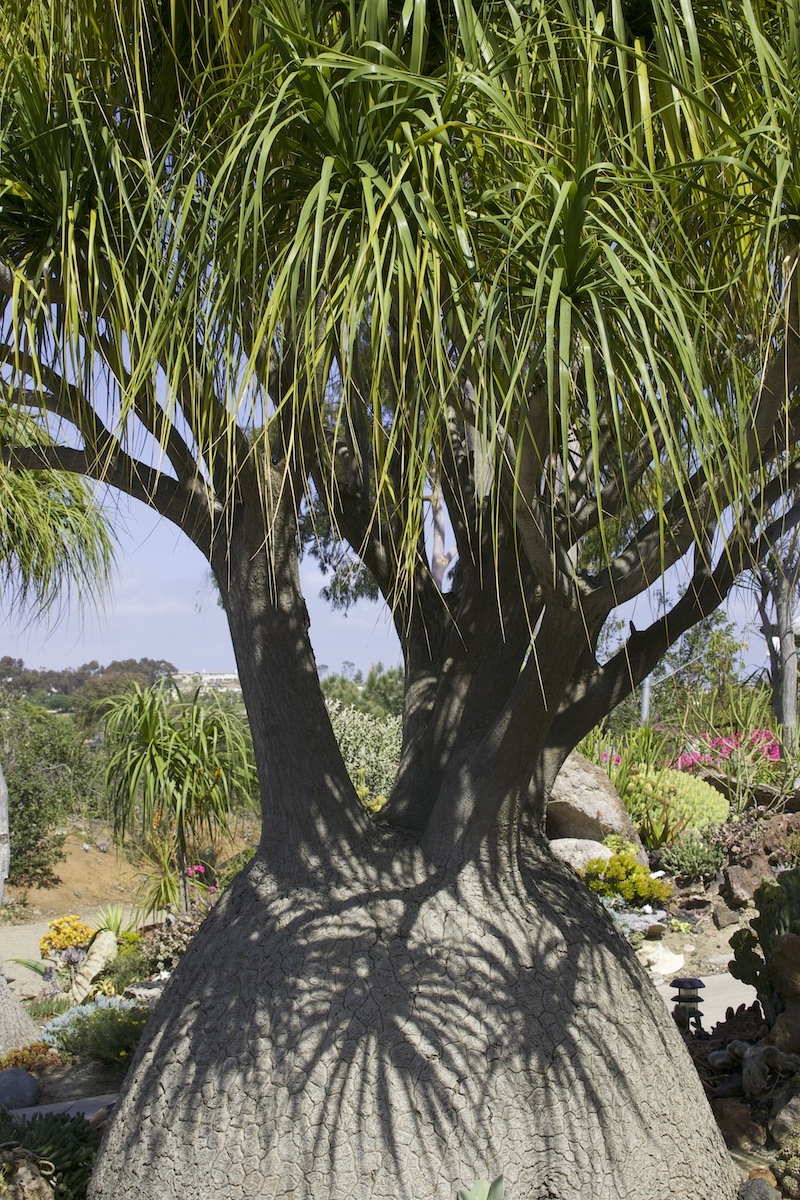
Shooting-star shadows on the caudex are a bonus with beaucarneas
Although the plants grow glacially, plan for their eventual girth and height. A caudex that starts out softball-sized may someday need a parking space. As you'll see in my Transplanting a Beaucarnea video, in-ground plants can attain three or four feet in diameter and six or seven feet in height in a dozen years or so. They may double that in 25 or 30.
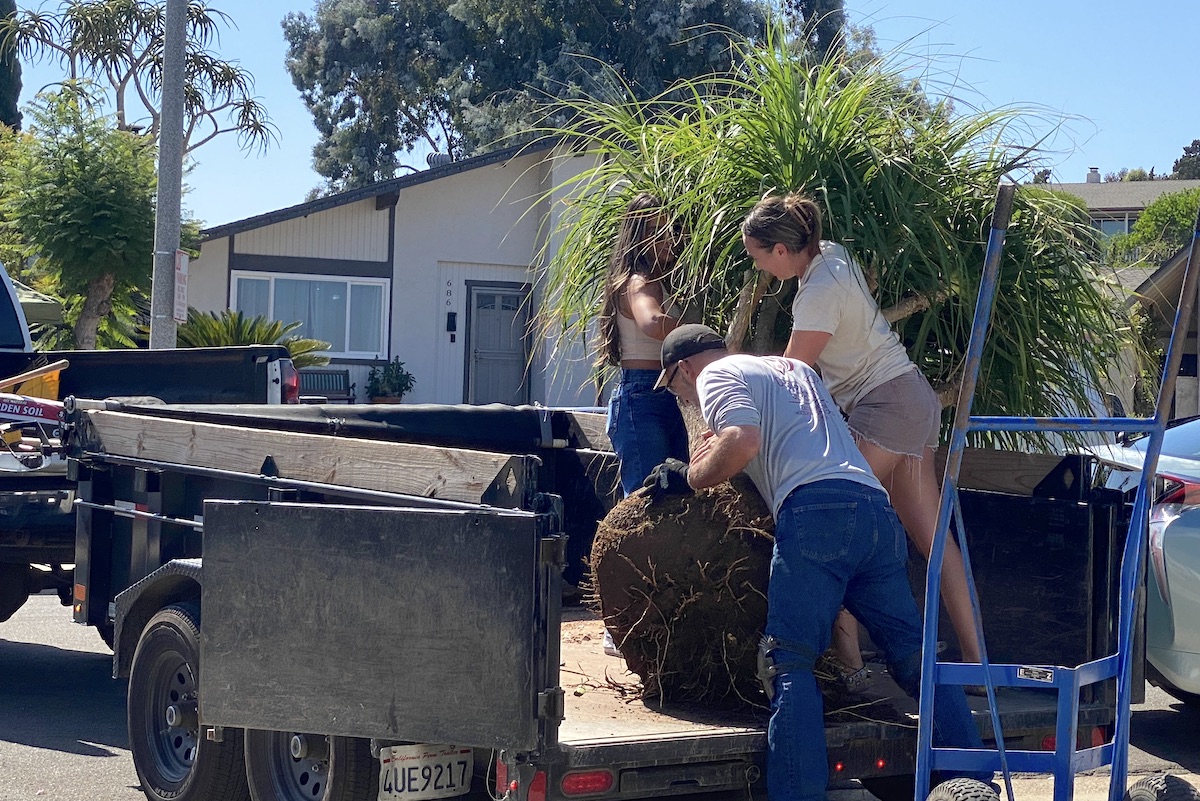
From the video: Team DFS loads a half-ton ponytail palm (Beaucarnea recurvata) onto a flatbed trailer
Also interesting, from the Irish book: "Species from more arid and inland climates often have very wide caudexes. Plants from more coastal and generally moister environments have narrower caudexes."
Of the whiskery, sparse roots, Laura Eubanks says, "they're optional." And because a plant can live off its caudex, "beaucarneas are the camels of the plant world."
Don't let it get waterlogged
Rot is a beaucarnea's biggest threat. Water indoor plants sparingly, once a month or so, and not at all in winter. Outdoors, position the caudex atop well-drained soil so rain or irrigation doesn't puddle around the base.
Btw, if soil happens to fall against the caudex, it may send roots into it. Clip them and remove the soil...or not...so long as the Hershey's Kiss caudex doesn't remain overly moist for an extended period.
The look
I'll bet Beaucarnea recurvata inspired whimsical trees in children's books by Dr. Seuss (who btw lived in San Diego).
I like beaucarneas best when compact and full. Three of mine have branched; the fourth---a Seussian topknot above a 5-foot trunk---I may take out. It's leaning toward the morning sun, and I'm tired of looking at it. (First, I may try cutting it back in the hope it'll branch.)
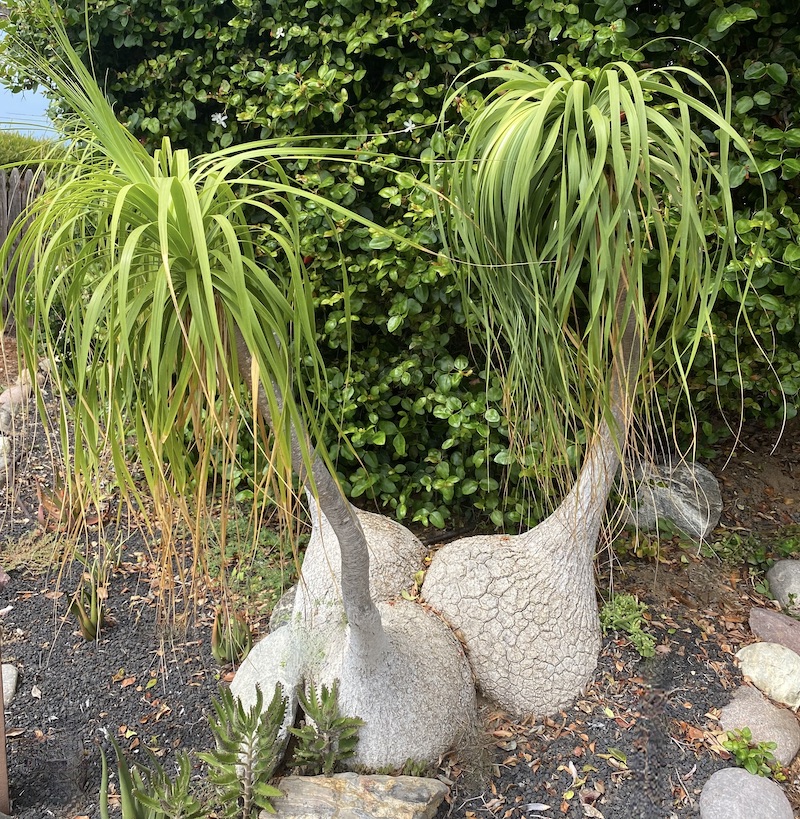
A triple-caudex, in-ground beaucarnea grouping at the Self Realization Fellowship Garden, Encinitas, CA
Flowers
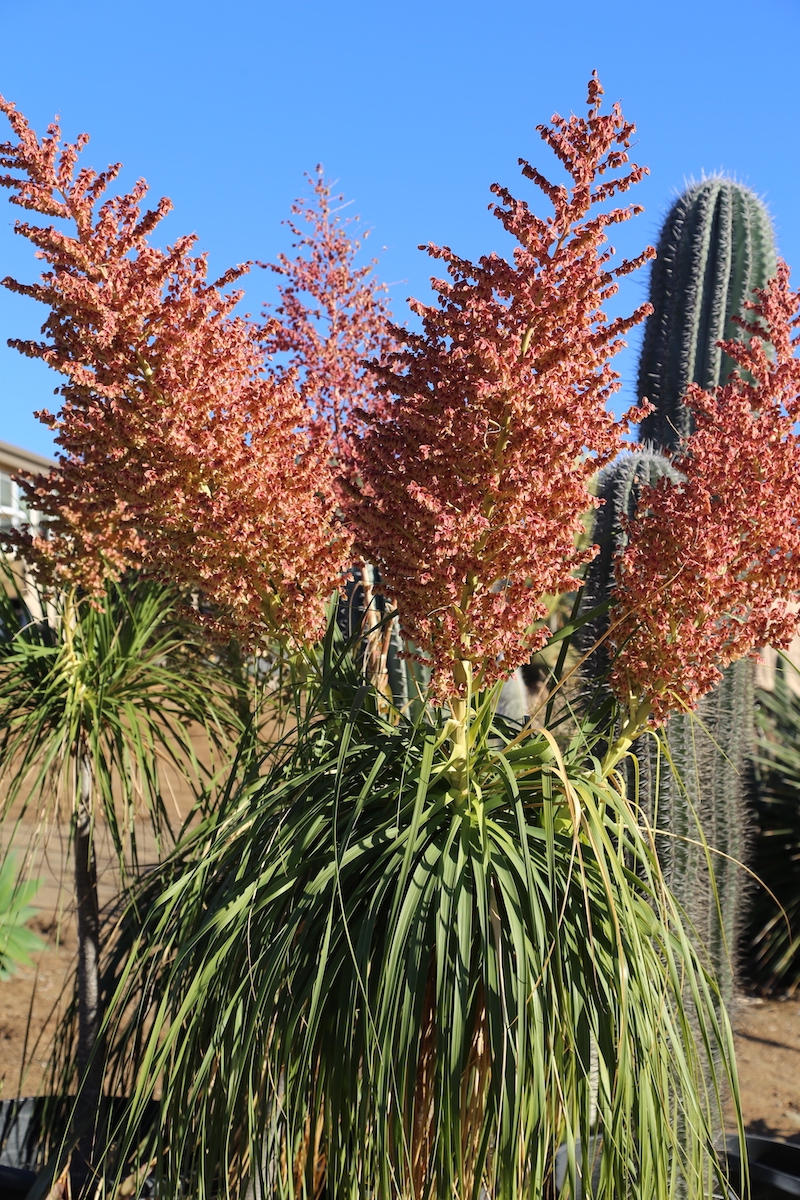
A female Beaucarnea recurvata has tall, fluffy sprays of pink seed pods
The plants are dioecious, meaning any given specimen is male or female. They bloom after 8 or 10 years with tall, feathery sprays of tiny, cream-colored flowers. Male flowers, which produce pollen, fade and become straw-like. Female flowers, if pollinated, form itty-bitty seed pods that blush shades of rosy pink.
So far only one of mine has bloomed, and the flowers stayed white, but that doesn't mean it isn't a female...merely that no males were nearby (and blooming) to provide pollen.
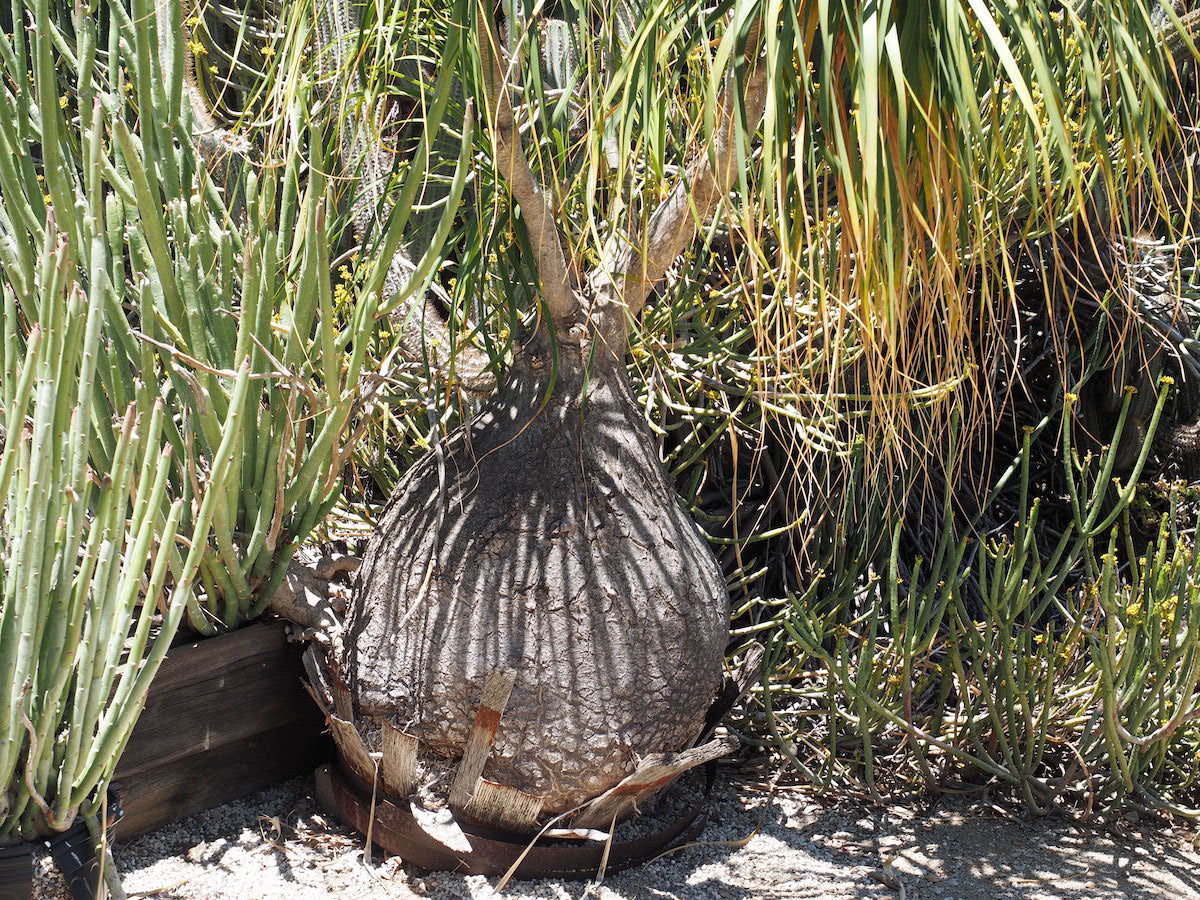
This neglected Beaucarnea recurvata at a nursery is attempting to plant itself
Grooming
Leaves may turn yellow and become brown-tipped over time. As lowest (older) ones wither, new top growth will replace them. Simply snip what's unsightly.
Lastly, do designate who gets your beaucarnea. It'll likely outlive you.
Related Info on this site
Types of Succulents from Aeonium to Zebra Plant, Photos & IDs
Debra’s Dozen Easy-Grow Succulent Plants for Beginners
Trying to make sense out of succulents? There are numerous varieties, but these are the most common succulents and those you’ll likely run across. Enjoy growing and discovering these fascinating “plants that drink responsibly!”
Succulent Landscapes
Succulent Landscapes Design ideas and must-dos for your yard’s transformation Want to transform your yard into a low-maintenance, low-water succulent garden? This page guides you to helpful info on this site and on my YouTube channel. Before you purchase plants or pick up a shovel, do obtain my book Designing with Succulents (2nd ed). It’s mainly about…

-custom_crop.jpg)
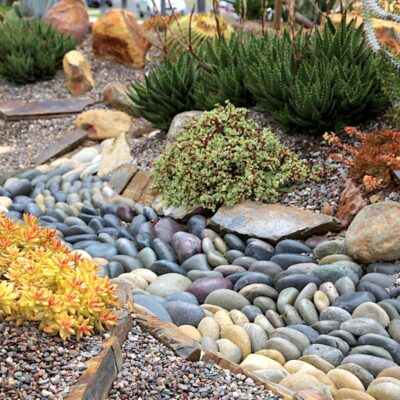
Oh, my! Just watched your YouTube video of Design for Serenity/Laura Eubanks and family relocating that magnificent Beaucarnea! I’ve so wanted one of these that I bought a tiny one in a 4” pot! I live on the Central Coast of California so I really want to plant it outdoors. Not many photos that I can find of what baby ones look like, my foliage is not a dark green at all. Fingers crossed! And thank you so much for posting the video and providing all the additional information on this blog. Love your books, too. 😃
Hi Cherry — I imagine now that you’re aware of ponytail palms, you’ll start noticing them. Your area should be fine for them. Baby ones look like a toilet plunger with a mop on top, LOL.
Oh I just caught that new video as well! I have one. About 3 years old in ground in northern California. I’d love to try beheading to incourage branching. Debra, when and at approx what size would you reccomend to do this? I’d love some input. That you for al the wonderful information.
Oh Debra, thanks for all the info and the new video! I have a nearly 3 yr old one in ground in Northern California. I’m considering chopping it’s head to encourage branching. Can you reccomend what season would be best for beheading? And at approximately what age? Thanks in advance.
Hi Mary — See my earlier response. Re the age…well…I think it’s more about size and its ability to withstand potential trauma. I wouldn’t go after a small, potted one. Since you’re in Northern CA, don’t do it in winter.
Debra thank you for posting this. I think Ponytail Palms are fabulous. I first really noticed them early in my career (landscape architecture) when I was sent to photograph a new commercial building we were working on in South Pasadena. Across the street is a large Victorian home behind a wall. Through the driveway gate I spotted a very large Ponytail Palm in the front yard. The caudex was at least 10’ diameter. That was almost 20 years ago. I’ve been a Ponytail fan an ever since.
The Ponytail Palm is still there and the caudex is bigger. I go by to check it every year and it’s still flourishing.
Hi Anne — What a wonderful story and memory. I love how it grew on you—and continued to grow in its location, framed by the gate. You’re clearly a kindred spirit. We plant people notice things like that!
Hello. Any tips on when to behead a ponytail palm? I have on outdoors for about 3 yrs old and 2 ft tall. I want to encourage branching like you mention. I’m in I think 9b.. 40 mins north of Sacramento in northern CA. Thanks in advance and for all your content!! Love you both so much.
Hi Mary — Not having done it myself yet, I hesitate to give advice, but what I plan to do is consistent with what I’ve read online at reliable gardening sites: Cutting it at the growing tip will make it branch. Do not cut the trunk because the tree may not re-sprout. I’ll probably cut mine six to 12 inches below its top, depending on where I think it’ll look best when it branches, in spring after all danger of frost.
Thank you so much! Sorry for the repeating questions… I didn’t realize they had all gone through. So exciting to get your advice. Wish me luck next spring!
Hi Debra. Loved the video of the ponytail been dug up and moved. I love them, I have had mine for 12 years and it flowered this year as did most of those around town here in Carnamah in western Australia. I was very intrigued by the gadget the man used to loosen the soil around the base I woul love one like it as our soil here is very similar to that he was digging. Many thanks.
It’s a small jackhammer with a spade attachment. Here’s a link: https://amzn.to/4eMyqQt
Hello, i’m from Brazil and we simply have a plant like this at the entrance to my house. It’s been here for almost 30 years, the same age i am, so i didn’t plant it. It’s impressive. I think it’s about 6 meters high and it’s blooming. i’d like to share a picture of it with you.